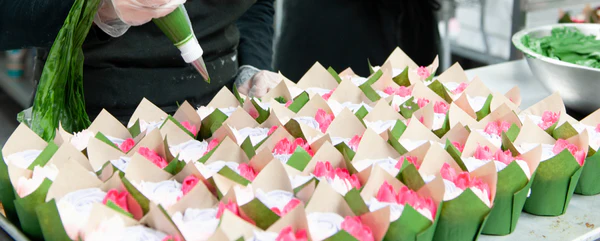There Are Many Different Types of Frosting. Which One Do I Choose?
Buttercream, cream cheese, fondant–how do you know which one best fits your cake? There are a ton of decisions that go into making a cake: the flavor, the filling, the toppings, and most importantly, the frosting. Cake frosting not only aids in a cake’s appearance but is also the first thing you taste when enjoying a slice of a cake. Whether you’re a baker or a buyer, it’s beneficial to know the cake frosting options that are out there when deciding what cake you want to make (or eat) next. We’ve highlighted the most popular types of frosting to help you get started!
The basics: buttercream frosting
Buttercream is the most popular type of frosting largely because of its few ingredients and easy application. Classic buttercream requires beating butter into icing sugar until you reach a frosting consistency. It’s not possible to over beat this type of frosting, so the longer you beat it, the fluffier it gets. Buttercream is not as flexible as fondant, though it can be used for the same applications.
Buttercream frosting is the most popular frosting for cupcakes, though it’s important to note that not all buttercream is made the same. If you want to decorate a cake with buttercream flowers, for example, it’s best to cut your butter quantity in half and replace it with solid vegetable shortening so the frosting is firm enough to hold the shape of the flower. Meanwhile, if you ever see very white colored buttercream cake icing, that usually means that butter wasn’t used at all. To make the white buttercream frosting, you will need to use a mix of powdered sugar and vanilla blended with straight shortening to hold it together. Butter gives the frosting a yellow hue, while straight shortening may leave a greasy film in your mouth. Depending on how you want to use your buttercream, what you want it to taste like, and what you want it to look like, the different variations of making buttercream are endless.

PICTURED: Pink Rose Layer Cake with pale pink buttercream roses
Intermediate: cream cheese frosting
An American-style buttercream cream cheese frosting is most commonly found on desserts like our carrot or red velvet cakes. At We Take The cake, we like to use vanilla and chocolate cream cheese frosting, too!

PICTURED: Red Velvet Bundt with cream cheese frosting
Intermediate: cooked frostings
Cooked frosting, also known as seven-minute frosting, is made from egg whites, sugar, and flavorings on top of a double boiler while beating with a mixer. As the mixture heats, a meringue will form. Because of this heating process, the frosting is extremely delicate and should be eaten the first day or risk the frosting being absorbed into the cake.
Expert baker: fondant
There are two main types of fondant: rolled and pourable. Rolled fondant is the most widely used when it comes to cake decorating. Made of sugar, water, gelatin, and food-grade glycerine, this dough-like texture makes it easy for a baker to mold the fondant into shapes to add some décor to your cake. Fondant can be used for decorations or to cover the entire cake.
Poured fondant, which has a glossy finish and is, unsurprisingly, of pourable consistency. This consistency makes it easy to coat a cake or cupcake.

PICTURED: Custom Cake partially covered with fondant
Expert baker: royal icing
Royal icing is one of the best icings for decorating cakes. Mixing together powdered sugar, egg whites, and meringue powder or liquid provides a consistency relative to pancake batter. This makes it easy to pour into pastry bags to fulfill your decorating dreams.
Royal icing sets almost instantly so that the design holds (which makes it one of the best cake icings), so be careful of mistakes. The way royal cake icing hardens is especially useful for making flowers.
Leaving the decisions up to the professionals
The types of frosting listed are just the tip of the icing. There are also ganache, glazes, syrups, and paste frostings to consider topping your cake with! It’s easy to get overwhelmed, but taking it one step at a time will ensure you can create a cake you are proud of.
In the case that you’d prefer to eat your cake and not make it too, we are here to help! At We Take The Cake, we take pride in creating beautifully packaged, frosted, and crafted cakes in all shapes and sizes. We go the extra mile to make sure we exceed your expectations by delivering an experience, not just a cake. Contact us today to learn about how we can help you with your next event!
Frequently Asked Questions
What is the most popular type of frosting for cakes?
The most popular type of frosting is buttercream, thanks to its creamy texture, sweet flavor, and versatility. It’s easy to make, can be tinted any color, and works well for piping, layering, and decorating. Variations like American, Swiss, or Italian buttercream allow bakers to adjust sweetness and consistency for different cake styles.
What frosting holds up best in warm weather?
For cakes served in warmer climates, fondant or shortening-based buttercream holds up best. Traditional butter-based frostings can soften quickly in heat, while fondant maintains its structure and appearance. If you prefer a creamy frosting, opt for a stabilized buttercream made with shortening or meringue powder.
What frosting tastes best with chocolate cake?
The best frosting for chocolate cake depends on your flavor preferences. Chocolate cream cheese frosting adds a tangy richness, while peanut butter or vanilla buttercream creates a sweet contrast. For a luxurious option, chocolate ganache enhances the cake’s depth and delivers a glossy, decadent finish.

